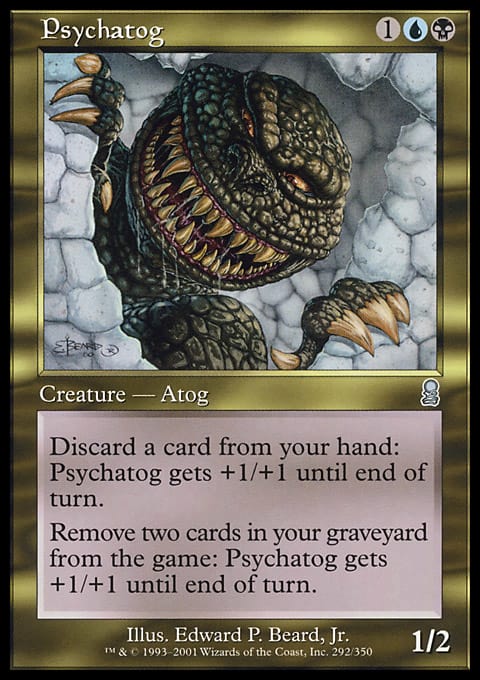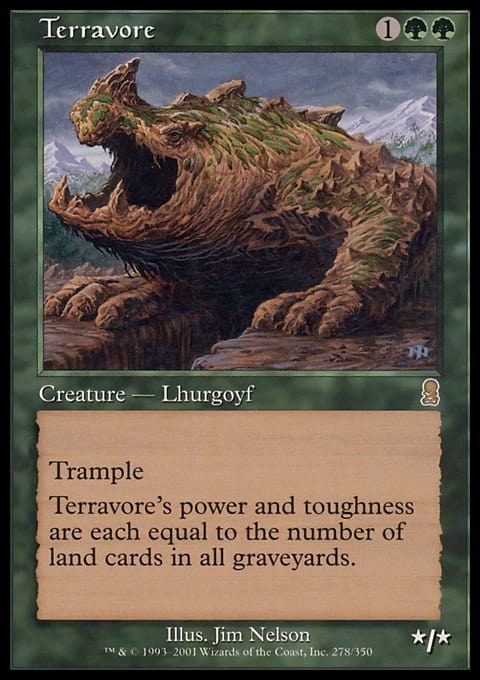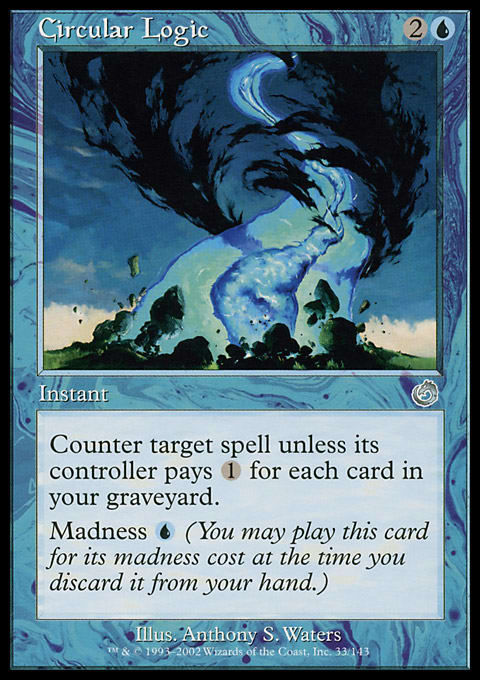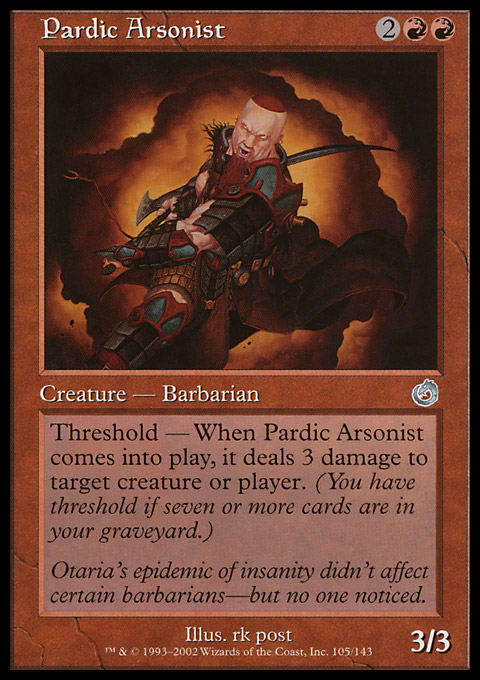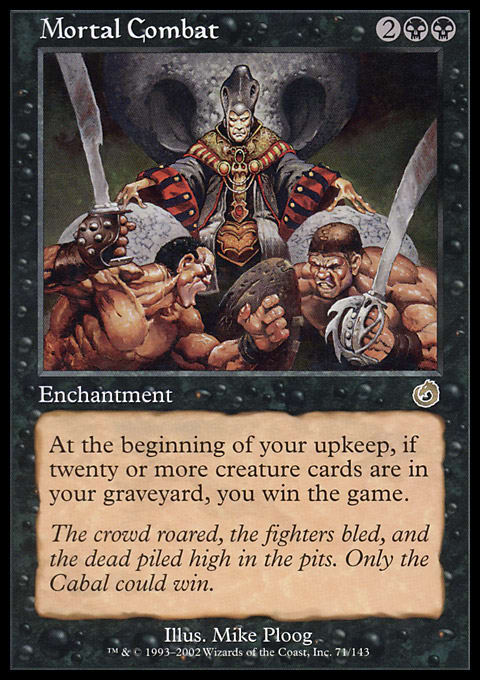Being a multicolored block (well, every block has five colors), Invasion was full of cycles. Odyssey’s layout, with the black-heavy Torment leading into the G/W Judgment, lessens the odds of horizontal cycles. Covering Invasion was a two-part exercise investigating twenty cycles; this time, I’m only looking at thirteen. How did they do in making the set awesome?
A reminder of the parameters:
- I’m looking at horizontal cycles (Titans), not vertical cycles (Penumbra Bobcat/Kavu/Wurm). They need at least five cards, though they don’t have to be in five colors.
- No all-common cycles. They tend to be boring.
- No land/mana cycles. They tend to be too similar for my purposes. Besides, every dual land is good.
I’m grading each cycle on three categories:
- Playability – Does this cycle have any cards people want to play?
- Depth – Was it hit-and-miss or strong overall?
- Resonance – Memorable cycles should be able to pass the flavor test, although some cycles are mechanical and are not intended to have shared flavor. Still, making all the cards cost the same, have similar names, or share other characteristics can make a cycle memorable when it otherwise wouldn’t be.
Here we go!
Odyssey
The New Fields
(Animal Boneyard, Chamber of Manipulation, Caustic Tar, Steam Vines, Squirrel Nest)
Playability: B
Depth: B
Resonance: C (mechanical cycle)
Enchant lands struggle to be memorable without flavor. They’re inherently unlikely to see much play, so they need to compensate for this with something. Surprisingly, the Fields cycle from Prophecy pulled this off almost perfectly by having strong flavor, reasonable playability, and subtle synergy with set themes.
This cycle doesn’t have much of that going for it. What it has is the $3 Squirrel Nest—repeatable Squirrel tokens will be forever popular—and underrated depth. In casual games, there’s rarely enough removal to hit all the problematic enchantments, never mind ones on a land, so you’re reasonably likely to keep one of these on the field should you want to.
Chamber of Manipulation is always just short of making my decks, but repeatable instant creature theft is worthwhile. I’ve played Caustic Tar, and it’s a strong effect; never underestimate dealing targeted life loss versus damage since, as you know, effects that prevent or redirect damage cannot be used to counter this loss of life. (Thank you, Keeper of Tresserhorn!)
Animal Boneyard has lands to do its job better, such as Miren, the Moaning Well, and Steam Vines just isn’t that good, but overall, this cycle’s all right. It does its job.
The Spheres
(Sphere of Truth, Sphere of Reason, Sphere of Grace, Sphere of Law, Sphere of Duty)
Playability: C
Depth: A−
Resonance: A
The unusual monochrome cycle, the Spheres play in the Circle of Protection design space by preventing 2 damage a source of a given color would deal. They’re all fairly equally playable, though Sphere of Law is best because it prevents red damage (similar to Circle of Protection: Red and Dragon's Claw being the relative standouts of their cycles).
It receives good marks as a cycle for costing ![]()
![]() and for synchronizing their names and flavor texts, as the idea behind the sphere does something. For example, “Reason exposes deception,” from Sphere of Reason. Each flavor text is three words, which is tough to do while being pithy. Christopher Moeller drew the art for all five pieces as well. None of that makes the cards jump into decks, but that attention to flavor detail has helped Magic stand out for years. Even its mediocre cards can enhance thematic unity.
and for synchronizing their names and flavor texts, as the idea behind the sphere does something. For example, “Reason exposes deception,” from Sphere of Reason. Each flavor text is three words, which is tough to do while being pithy. Christopher Moeller drew the art for all five pieces as well. None of that makes the cards jump into decks, but that attention to flavor detail has helped Magic stand out for years. Even its mediocre cards can enhance thematic unity.
The Office of Dr. Teeth
(Phantatog, Psychatog, Sarcatog, Lithatog, Thaumatog)
Playability: A
Depth: C−
Resonance: A−
Often, a high mark on playability—a card or two is really good—makes depth suffer since there’s such a wide spread on abilities. Why does that matter? Basically, while playability is important for people caring about any of the cycle, depth ensures that those playable cards are remembered as a cycle.
Psychatog is a classic example of the difference in how cycles are remembered. Each of these uncommon 1/2 Atogs costs ![]() CD (a generic mana and one each of two different colors), with two different things it can eat based on its colors. White Atogs eat enchantments, blue ones eat cards in your hand, black ones eat your graveyard, red ones eat artifacts, and green ones eat lands.
CD (a generic mana and one each of two different colors), with two different things it can eat based on its colors. White Atogs eat enchantments, blue ones eat cards in your hand, black ones eat your graveyard, red ones eat artifacts, and green ones eat lands.
The callback to the original Atog helps bind them together as a cycle as well. It would be a resonant cycle by itself, but it ties so effectively into Magic’s past that it gets high marks. But while most people know this is a cycle, few people can name the cards in the cycle apart from Psychatog. That’s because Psychatog is so much better than the others, an uncommon powerful enough to be the win condition (with its buddy Upheaval) of control decks in Standard and Extended until Wizards printed a critical mass of graveyard hate.
In retrospect, Psychatog feels like the last descendant of Serra Angel from The Deck, the original permission-control/unstoppable-finisher deck. The Psychatog deck was the last important control deck to use Counterspell, it was one of the last decks to avoid tapping out on the turn it cast its finisher, and it was one of the last decks to be able to rely on a single creature for its damage. Being in the original/old card frame helps make it feel a part of a history long gone. Don’t get me wrong; I always hated facing Psychatog, as the guy who taught me to play had a Psychatog deck that vexed me as a novice. But modern Magic has gone away from this model of deck so much that newer players wouldn’t look at this card and see the big deal, and that saddens me as a Magic history buff.
While Psychatog is a household card name for players of a certain era, few people can name any of the other Atogs in the cycle because Psychatog was so good. The resonance helps people remember, “Oh yeah, there’s a cycle of Atogs,” but the others don’t match up to Psychatog in any meaningful way. Given Psychatog’s track record, I’m not sure how they could, but that’s how a cycle becomes graded.
Shrined and Dined
(Aven Shrine, Cephalid Shrine, Cabal Shrine, Dwarven Shrine, Nantuko Shrine)
Playability: B−
Depth: F
Resonance: B
Given that this is one of the most maligned cycles of all time, the Playability rating might surprise you, but Nantuko Shrine was a decent build-around. The others are stunningly terrible, however. Each card is a ![]() CC enchantment that gives you an effect when a spell is cast and has the same name as one or more in a graveyard. You could gain life, counter the spell, make an opponent discard, deal damage, or make Squirrels for this Flame Burst–styled circumstance.
CC enchantment that gives you an effect when a spell is cast and has the same name as one or more in a graveyard. You could gain life, counter the spell, make an opponent discard, deal damage, or make Squirrels for this Flame Burst–styled circumstance.
But unless you’re playing with Relentless Rats, you’re normally going to get so little out of these (e.g. nothing from the first one) that there’s no point to playing them. The tight mana cost across the cycle and being all Shrines that key off races (or an organization in the case of the Cabal) make them obvious as a cycle, which is partially why they’re so unpopular. Wizards made it easy to hate the Shrines. That speaks well to flavor but not to anything else.
’Vore Ovaltine Please
(Cantivore, Cognivore, Mortivore, Magnivore, Terravore)
Playability: A
Depth: A−
Resonance: B+
For unknown reasons, this cycle’s never received the respect it deserves as a cycle. My guess is that each of its members was playable at different times and formats so that no two shared a spotlight. This is highly unusual, and off the top of my head and from the cycles I’ve reviewed so far, I can’t think of any cycle that’s acted remotely like this one.
Each creature’s a Lhurgoyf counting a card type in your graveyard. Cantivore’s the weak member of the cycle for counting enchantments, but the rest turn out to be easily abusable. Mortivore’s a casual staple, coming back into the spotlight as part of The Mimeoplasm’s Commander deck (if you exile Mortivore for +1/+1 counters on The Mimeoplasm, it will be however many creatures were in all graveyards thanks to rules on characteristic-defining abilities).
The others have been at the heart of tournament decks. Cognivore was the first one to see play, comboing with an instant-heavy Oath of Druids deck in what’s best described as a fairer version of Dark Depths–Vampire Hexmage. Magnivore followed several years later in its Ninth Edition reprinting as the finisher in the surprisingly brutal Annex-Wildfire Standard decks of that era. Terravore is still seen in Legacy; it was the heft in Aggro Loam decks but now shows up in Knight of the Reliquary builds.
That’s an incredibly impressive record. Finishers from Standard to Legacy and a casual staple is about as perfect as you can get. They’re not in a major creature type, they’re not multicolored, and they’re not legendary, but they’ve been a major part of the game. Well done. Certainly better than my pun title for the cycle.
These Are Not From Invasion
(Iridescent Angel, Shadowmage Infiltrator, Vampiric Dragon, Decimate, Mystic Enforcer)
Playability: A−
Depth: A−
Resonance: C− (nothing apart from colors and rarity ties them together)
That Jon Finkel is not only part of a cycle but one primarily known for casual is as counterintuitive as it comes, but at least he’s part of a good cycle. I’ve built around Decimate and played Mystic Enforcer in my Verdant Succession deck, and they’re both fantastic. The others definitely have their fans, and for good reason. The only annoying thing is that the cycle has four creatures and one sorcery. As the only two-colored rares in Odyssey, they must be a cycle, but having one sorcery in the group is annoying. If it’s going to be a noncreature, though, it might as well be one of the most awesome R/G spells ever.
Torment
Cycle Madness
(Strength of Isolation, Circular Logic, Strength of Lunacy, Volcanic Eruption, Arrogant Wurm)
Playability: A−
Depth: C−
Resonance: B−
Another cycle in the Psychatog line; they’re uncommons with madness with two of them so strong that they obscure the others. In this case, there’s no flavor to tie them; they’re simply the uncommons with madness. The intriguing thing about the cycle is that its two Standard playables, Circular Logic and Arrogant Wurm, were in the same Standard deck, U/G Madness.
If you’ve never played it, you should put it together; if you don’t splash the Ray of Revelation in Dave Humphreys’s 2003 Worlds Top 4 version, you can take out City of Brass and make the deck without rares. Can you feel bad about net-decking when you’re doing it without rares? I don’t. In any event, madness was a silly mechanic, and Circular Logic with Arrogant Wurm made this cycle a hit even if the other cards don’t matter.
The Enchantments Whose Artworks Creep Me Out to the Extent that I Don’t Like Talking about The Cards
(Hypochondria, Compulsion, Mortiphobia, Pyromania, Narcissism)
Playability: B−
Depth: B+
Resonance: ? (Probably high, but how do I rank creeping me out?)
It’s a little high-concept to name a cycle of spells after mental conditions, a little weird to make them enchantments that give you benefits, a little weirder for Christopher Moeller (from the Sphere cycle) to illustrate them all, and bizarre to make most of the artworks about odd creatures with masks.
Each enchantment lets you discard a card or sacrifice the enchantment for a minor effect that’s nice to repeat. My understanding is that these were useful in Limited as a discard outlet—that’s their ceiling. But seriously, the artwork unnerves me to the point that I really don’t like thinking about this cycle. I don’t think I have this visceral a reaction to any other artworks in the game—not even all the Ron Spencer pieces I hate. You can’t get a reaction if the cycle isn’t well done, I suppose, but that doesn’t make me like it. Ew. Let’s move on.
The Threshold of Playability
(Teroh's Vanguard, Cephalid Sage, Gloomdrifter, Pardic Arsonist, Centaur Chieftain)
Playability: B
Depth: B
Resonance: B− (mechanical cycle, but they all cost 4 mana)
Each of these is an essentially vanilla 4-drop that gives you a benefit at threshold. Gloomdrifter’s easily the best of these and the one that’s seen the most play past Limited; giving -2/-2 to all nonblack creatures is a great deal on a 2/2 flyer.
Centaur Chieftain has a few applications, especially due to its haste. Pardic Arsonist costs ![]()
![]()
![]() rather than
rather than ![]()
![]() as it would if it lined up with the rest of the cycle (bad resonance!), but that’s probably because it was born in the shadow of Flametongue Kavu, the threshold ability of which Arsonist’s resembles. Teroh's Vanguard is too narrow for most applications, but Cephalid Sage is okay. This isn’t an exciting cycle by any means, but it’s done its job over the years. The shrug with which I approach this cycle is a pleasant shrug.
as it would if it lined up with the rest of the cycle (bad resonance!), but that’s probably because it was born in the shadow of Flametongue Kavu, the threshold ability of which Arsonist’s resembles. Teroh's Vanguard is too narrow for most applications, but Cephalid Sage is okay. This isn’t an exciting cycle by any means, but it’s done its job over the years. The shrug with which I approach this cycle is a pleasant shrug.
The Dreams
(Vengeful Dreams, Turbulent Dreams, Insidious Dreams, Devastating Dreams, Nostalgic Dreams)
Playability: B+
Depth: A−
Resonance: B
Each dream, as the flavor text lets on, is supposed to be the dream of some legendary character in the story. “Teroh dreams of his enemies’ doom,” while, “Kamahl dreams of storms of fire.” These dreams are realized by discarding X cards to achieve an effect X large. This part is pretty resonant. What isn’t is the slight tweaks that make you think you know what the other cards in the cycle do, only to find out one is different. I don’t like when cycles do that because it lessens comprehension of the set when the cycles are supposed to provide a sort of instant clarity.
All the Dreams cost 2 mana of one color—except for Insidious Dreams, costing ![]()
![]() . Devastating Dreams discards X cards at random; the other ones let you choose your cards. Two of the cycle are instants, and three are sorceries. Nostalgic Dreams exiles itself as part of its resolution. All of these are necessary for the specific cards’ abilities, but that weakens it as a cycle.
. Devastating Dreams discards X cards at random; the other ones let you choose your cards. Two of the cycle are instants, and three are sorceries. Nostalgic Dreams exiles itself as part of its resolution. All of these are necessary for the specific cards’ abilities, but that weakens it as a cycle.
That said, they’re very playable when built around. Insidious Dreams lets you spellshape your excess hand into a manifold Vampiric Tutor, while Devastating Dreams is as bad as it sounds, turning your hand into a huge-for-one on lands and creatures. The others are decent, though not as backbreaking and therefore maybe too finicky. But they’re all good considerations for a deck that wants discard outlets and large effects. Not every cycle is going to be amazing, so being pretty good is . . . well . . . pretty good.
Bonus points to Insidious Dreams for being the only card I know that’s part of a horizontal cycle and a vertical cycle, as it’s also the rare for common Restless Dreams and uncommon Sickening Dreams. If Odyssey block is a Jeopardy! category, you’re set now. My commission on your win is reasonable.
Judgment
The Incarnations
(Valor, Wonder, Filth, Anger, Brawn)
Playability: A
Depth: B+
Resonance: A
Judgment has only two cycles to itself, but both are iconic. The Incarnations are creatures that give a keyword while in your graveyard. Across the colors, they give first strike, flying, swampwalk, haste, and trample. (Glory and Genesis are rare Incarnations with activated and triggered abilities rather than static ones.) Wonder was an important Standard card in threshold/madness decks, and Anger’s been on the radar occasionally for any deck that wants mass haste.
If you fancy yourself a card designer, this cycle should be your inspiration for a memorable cycle. They’re all ![]()
![]() and have that tombstone icon in the top left, one-word names, a unique creature type, a keyword ability it has when in play that it will grant your creatures if it’s dead, and flavor text from the Scroll of Beginnings. They pulled out all the stops to make this a memorable cycle, and for tournament and casual playability, they nailed it.
and have that tombstone icon in the top left, one-word names, a unique creature type, a keyword ability it has when in play that it will grant your creatures if it’s dead, and flavor text from the Scroll of Beginnings. They pulled out all the stops to make this a memorable cycle, and for tournament and casual playability, they nailed it.
The Wishes
(Golden Wish, Cunning Wish, Death Wish, Burning Wish, Living Wish)
Playability: A
Depth: A
Resonance: B
Easily memorable despite being incredibly niche, the Wishes were vital to tournament Magic for a long time, particularly when they could retrieve cards in exile and in your sideboard. Now they only go for the sideboard, but that still makes Burning Wish and Cunning Wish viable cards in some decks. Casual’s never warmed to these, in large part because “outside the game” is tough to work with. Magic Online lets you search your entire collection, which is time-consuming even when digitally organized.
It’s tough to say more than that about the cycle because they’re so narrow. But they have a solid track record since they’re almost the only cards in their design space. They made the mana costs reasonable enough to get them in tournaments rather than leave them as weird cards in binders, and that’s for the best. These could have gone the way of the Shrines. Nobody wants that.
The Slow Reveals
(Test of Endurance, Battle of Wits, Mortal Combat, Chance Encounter, Epic Struggle)
Playability: B+
Depth: B
Resonance: A−
The extra marks for resonance are due to the cycle’s clever manipulation through the block. Battle of Wits and Chance Encounter were in Odyssey, making strange cards that could be seen as one-ofs (though Battle of Wits wound up being powerful enough to win tournaments in the most visually memorable deck of all time). Then, the black-heavy Torment printed Mortal Combat, making it feel like a cycle. Judgment focused on green and white throughout the set, showing prominently in its completion of the cycle with Test of Endurance and Epic Struggle.
As individual cards, they encourage very different decks. I’ve won with Battle of Wits and lost to Mortal Combat and Epic Struggle; the experiences didn’t overlap much in terms of gameplay. Certainly they wouldn’t overlap with Chance Encounter. But the biggest thing here is, like with the Wishes, how you can make even a weird cycle do major work in helping players understand the set. This was the first cycle to seed its members across all three sets of a block (it’s the only one I can think of; we’ll see if it holds up in later articles). That would be novel in itself, but they went one further with it and made sure to print the black one in the black set and the green and white ones in the green and white set. You subtly get some of the storyline and set themes from a cycle of enchantments that talk about having two hundred cards in your library and winning coin flips. That’s a lot of work out of what are Johnny junk rares at heart.
Conclusion
Invasion block lent itself to cycles, many of which are still played and loved. Odyssey was sold more on its mechanics than its cycles, and some of its most memorable cards aren’t remembered as part of a cycle (Shadowmage Infiltrator, Circular Logic, Arrogant Wurm), but the Wishes and the alternate win conditions showed how important cycles could be in coalescing unconventional ideas and supporting a set. There are several historically relevant cards in this article, and the cycles are generally well-designed apart from the Shrines. Taken together, Invasion and Odyssey blocks highlight how cycles can take lead or supporting roles, and they feel like the start of modern design and marketing in that sense. It’s a job well done.
















